Numerical Analysis on the Mechanical Properties of the Concrete Precast Pavement of Runways under the Wheel Load
Abstract
:1. Introduction
2. Theories and Methods
2.1. Load Model of a Pavement Slab under an Aircraft Load
- (1)
- Aircraft load model simulation
- (2)
- Aircraft wheel load simulation
2.2. Finite Element Numerical Model of Runway Foundation
3. Results and Discussion
3.1. When an Aircraft Load Acts on the Slab
3.2. When the Aircraft’s Load Acts on the Slab Edge
3.3. When the Aircraft Load Acts on Joints
3.4. Changes in Aircraft Load Acting on Different Positions of the Pavement Slab
3.5. Laboratory Test Verification
- the results are different due to the different conditions in laboratory test facilities and human errors;
- the results do not consider the stress and deformation caused by temperature changes on the pavement slab.
4. Conclusions
- (1)
- The vertical displacement of the slab at the slab’s edge, and the connection between neighboring slabs, was relatively significant, with the greatest vertical displacement measuring at 1.92 mm and 1.71 mm, respectively. The coefficient of the transverse displacement attenuation of the wheel load operating on the center of the slab and the edge of neighboring slabs was comparable. A high deflection deformation on the transverse direction of the pavement slab was present, together with a small attenuation coefficient and a complex stress condition at the junction point.
- (2)
- The effect of the dowel bar on the load-bearing pavement slab was minimal, regardless of the slab’s different positions. The deflection load transfer coefficient of the loaded slab, relative to the unloaded slab, was 56.03% when the wheel load was acting on the center of the slab. The deflection load transfer coefficient that was measured when the wheel load was acting at the slab’s edge, was 27.08%. The conclusion that the dowel bar’s load transfer efficiency was lower when the aircraft wheel load was closer to another unloaded slab is based on the fact that when the wheel load acted on the joint of adjacent pavement slabs, the dowel bar rarely modified the load transfer of the pavement; however, it did affect the force at the joint point.
- (3)
- The edges of nearby slabs underwent the most vertical stress after the dowel bar was introduced, followed by center of the slab, and finally, the slab’s joints. The three vertical stresses were 0.295 MPa, 0.289 MPa, and 0.178 MPa. The junctions experienced the highest bending stress, which was then followed by the slab’s edges, and finally, the center of the slab. The bending stresses were 0.072 MPa, 0.025 MPa, and 0.016 MPa, respectively.
- (4)
- After comparing the laboratory test data with the simulation calculation, the results were found to be similar. The joint between the edge of the precast pavement slab and the neighboring pavement slab was the most unfavorable position of the precast pavement slab under the aircraft’s wheel load. This finding may help to understand the illness and damage mechanisms of existing pavement slab edges and joints. The warping distortion of the pavement slab along its edges and its surroundings, caused by the wheel load, would have a significant impact on the smoothness of the airport’s cement concrete pavement; therefore, in the future, it will be necessary to use theoretical numerical simulations and field tests to further verify the warping deformation of the slab, and to investigate the deformation of the slab caused by the effect of the temperature, the wheel load, and the stress characteristics along the direction of the slab’s thickness.
Author Contributions
Funding
Institutional Review Board Statement
Informed Consent Statement
Data Availability Statement
Acknowledgments
Conflicts of Interest
References
- Faheem, M.; Tahir, M.; Mustafa, M.; Bakri, A. Potential of industrial By-Products based geopolymer for rigid concrete pavement application. Constr. Build. Mater. 2022, 344, 128190. [Google Scholar] [CrossRef]
- Fang, M.; Zhou, R.; Ke, W.; Tian, B.; Zhang, Y.; Liu, J. Precast system and assembly connection of cement concrete slabs for road pavement: A review. J. Traffic Transp. Eng. (Engl. Ed.) 2022, 9, 208–222. [Google Scholar] [CrossRef]
- Chhorn, C.; Hong, S.J.; Lee, S.W. A study on performance of roller-compacted concrete for pavement. Constr. Build. Mater. 2017, 153, 535–543. [Google Scholar] [CrossRef]
- Chen, Y.; Cen, G.; Cui, Y. Comparative study on the effect of synthetic fiber on the preparation and durability of airport pavement concrete. Constr. Build. Mater. 2018, 184, 34–44. [Google Scholar] [CrossRef]
- Ganiron, T.U.J. Effects of Human Hair Additives in Compressive Strength of Asphalt Cement Mixture. Int. J. Adv. Sci. Technol. 2014, 67, 11–22. [Google Scholar] [CrossRef]
- Seehra, S.S.; Gupta, S.; Kumar, S. Rapid setting magnesium phosphate cement for quick repair of concrete pavements—Characterisation and durability aspects. Cem. Concr. Res. 1993, 23, 254–266. [Google Scholar] [CrossRef]
- Peng, P.; Yuan, Z.; Tian, B.; Niu, K. Research on application of precast-assemble technology to road maintenance engineering. Appl. Mech. Mater. 2013, 361–363, 1693–1698. [Google Scholar] [CrossRef]
- Jordaan, G.J.; Steyn, W.J.V. Nanotechnology Applications towards Sustainable Road Surface Maintenance and Effective Asset Protection, Generating Rapid Employment Opportunities in a Post COVID-19 Era. Appl. Sci. 2022, 12, 2628. [Google Scholar] [CrossRef]
- Wang, Y.; Kong, L.; Chen, Q.; Lau, B.; Wang, Y. Research and application of a black rapid repair concrete for municipal pavement rehabilitation around manholes. Constr. Build. Mater. 2017, 150, 204–213. [Google Scholar] [CrossRef]
- Tayabji, S.; Tyson, S. Precast concrete pavement innovations, performance and best practices. Concr. Int. 2014, 39, 41–46. [Google Scholar]
- Tayabji, S.; Ye, D.; Buch, N. Precast concrete pavements: Technology overview and technical considerations. PCI J. 2013, 58, 112–128. [Google Scholar] [CrossRef] [Green Version]
- Murugan, R.B.; Natarajan, C.; Chen, S.E. Material development for a sustainable precast concrete block pavement. J. Traffic Transp. Eng. (Engl. Ed.) 2016, 3, 483–491. [Google Scholar] [CrossRef]
- Merritt, D.; McCullough, B.F.; Burns, N.H. Feasibility of using precast concrete panels to expedite construction of portland cement concrete pavements. Transp. Res. Rec. 2001, 1761, 3–9. [Google Scholar] [CrossRef]
- Hu, W.; Li, Y.; Yuan, H. Review of Experimental Studies on Application of FRP for Strengthening of Bridge Structures. Adv. Mater. Sci. Eng. 2020, 2020. [Google Scholar] [CrossRef]
- Noël, M.; Soudki, K. Fatigue Behavior of Full-Scale Slab Bridge Strips with FRP Reinforcement. J. Compos. Constr. 2015, 19, 04014047. [Google Scholar] [CrossRef]
- Ma, H.; Zhang, Z. Paving an engineered cementitious composite (ECC) overlay on concrete airfield pavement for reflective cracking resistance. Constr. Build. Mater. 2020, 252, 119048. [Google Scholar] [CrossRef]
- Hu, H.; Dong, C.Z.; Wang, J.; Chen, J. Experimental study of the fatigue performance of the bonding surfaces and load-bearing capacity of a large-scale severely damaged hollow slab strengthened by cfrp. Sustainability 2021, 13, 12179. [Google Scholar] [CrossRef]
- Sorelli, L.G.; Meda, A.; Plizzari, G.A. Steel fiber concrete slabs on ground: A structural matter. ACI Struct. J. 2006, 103, 551–558. [Google Scholar] [CrossRef]
- Xiaochun, Q.; Xiaoming, L.; Xiaopei, C. The applicability of alkaline-resistant glass fiber in cement mortar of road pavement: Corrosion mechanism and performance analysis. Int. J. Pavement Res. Technol. 2017, 10, 536–544. [Google Scholar] [CrossRef]
- Mounes, S.M.; Karim, M.R.; Mahrez, A.; Khodaii, A. An overview on the use of geosynthetics in pavement structures. Sci. Res. Essays 2011, 6, 2251–2258. [Google Scholar] [CrossRef]
- Qu, B.; Weng, X.z.; Zhang, J.; Mei, J.j.; Guo, T.x.; Li, R.f.; An, S.h. Analysis on the deflection and load transfer capacity of a prefabricated airport prestressed concrete pavement. Constr. Build. Mater. 2017, 157, 449–458. [Google Scholar] [CrossRef]
- Hargett, E.R. Prestressed concrete panels for pavement construction. PCI J. 1970, 43–49. [Google Scholar] [CrossRef]
- Boyd, A.J.; Liang, N.; Green, P.S.; Lammert, K. Sprayed FRP repair of simulated impact in prestressed concrete girders. Constr. Build. Mater. 2008, 22, 411–416. [Google Scholar] [CrossRef]
- Issa, M.A.; Idriss, A.T.; Kaspar, I.I.; Khayyat, S.Y. Full depth precast and precast, prestressed concrete bridge deck panels. PCI J. 1995, 40. [Google Scholar] [CrossRef]
- Sacks, R.; Eastman, C.M.; Lee, G. Process Model Perspectives on Management and Engineering Procedures in the Precast/Prestressed Concrete Industry. J. Constr. Eng. Manag. 2004, 130, 130–206. [Google Scholar] [CrossRef]
- JBull, W.; Woodford, C.H. Design of precast concrete pavement units for rapid maintenance of runways. Comput. Struct. 1997, 64, 857–864. [Google Scholar] [CrossRef]
- Senseney, C.T.; Smith, P.J.; Snyder, M.B. Precast concrete paving repairs at vancouver international airport. Transp. Res. Rec. 2021, 2675, 439–448. [Google Scholar] [CrossRef]
- Chen, Y.S.; Murrell, S.D.; Larrazabal, E. Precast concrete (PC) pavement tests on Taxiway DD at LaGuardia Airport. In Airfield Pavements: Challenges and New Technologies; ASCE: Reston, VA, USA, 2004. [Google Scholar]
- Abdualla, H.; Ceylan, H.; Kim, S.; Taylor, P.C.; Gopalakrishnan, K.; Cetin, K. Hydronic Heated Pavement System Using Precast Concrete Pavement for Airport Applications. In Proceedings of the International Conference on Transportation and Development 2018: Airfield and Highway Pavements, Pittsburgh, PA, USA, 15–18 July 2018; American Society of Civil Engineers: Reston, VA, USA, 2018; Volume 2018, pp. 16–24. [Google Scholar] [CrossRef]
- Ping, H.; Qi, Z.D.; Hui, L.; Feng, S.G.; Jun, T.Y. Research of prestressed concrete hollow multi-ribbed composite box girder. Adv. Mater. Res. 2012, 368–373, 705–709. [Google Scholar] [CrossRef]
- Šrámek, M.; Novák, J. Non-linear analysis of precast concrete element for airport pavement. Solid State Phenom. 2019, 292 SSP, 153–158. [Google Scholar] [CrossRef]
- Davis, E.H.; Poulos, H.G. The use of elastic theory for settlement prediction under three-dimensional conditions. Geotechnique 1968, 18, 67–91. [Google Scholar] [CrossRef]
- Li, C.; Ashlock, J.C.; Lin, S.; Vennapusa, P.K.R. In situ modulus reduction characteristics of stabilized pavement foundations by multichannel analysis of surface waves and falling weight deflectometer tests. Constr. Build. Mater. 2018, 188, 809–819. [Google Scholar] [CrossRef]
- Marecos, V.; Solla, M.; Fontul, S.; Antunes, V. Assessing the pavement subgrade by combining different non-destructive methods. Constr. Build. Mater. 2017, 135, 76–85. [Google Scholar] [CrossRef]
- Li, Y.; Song, G.; Cai, J. Mechanical Response Analysis of Airport Flexible Pavement Above Underground Infrastructure Under Moving Wheel Load. Geotech. Geol. Eng. 2017, 35, 2269–2275. [Google Scholar] [CrossRef]
- Maina, J.W.; Ozawa, Y.; Matsui, K. Linear elastic analysis of pavement structure under non-circular loading. Road Mater. Pavement Des. 2012, 13, 403–421. [Google Scholar] [CrossRef]
- Liu, S.; Ling, J.; Tian, Y.; Hou, T.; Zhao, X. Random Vibration Analysis of a Coupled Aircraft/Runway Modeled System for Runway Evaluation. Sustainability 2022, 14, 2815. [Google Scholar] [CrossRef]
- Liu, S.; Tian, Y.; Liu, L.; Xiang, P.; Zhang, Z. Improvement of boeing bump method considering aircraft vibration superposition effect. Appl. Sci. 2021, 11, 2147. [Google Scholar] [CrossRef]
- Tian, Y.; Liu, S.; Liu, L.; Xiang, P. Optimization of international roughness index model parameters for sustainable runway. Sustainability 2021, 13, 2184. [Google Scholar] [CrossRef]
- Gagliardi, P.; Teti, L.; Licitra, G. A statistical evaluation on flight operational characteristics affecting aircraft noise during take-off. Appl. Acoust. 2018, 134, 8–15. [Google Scholar] [CrossRef]
- Xu, H.; Xiao, K.; Cheng, J.; Yu, Y.; Liu, Q.; Pan, J.; Chen, J.; Chen, F.; Fu, Q. Characterizing aircraft engine fuel and emission parameters of taxi phase for Shanghai Hongqiao International Airport with aircraft operational data. Sci. Total Environ. 2020, 720, 137431. [Google Scholar] [CrossRef]
- Wang, H.; Al-Qadi, I.L. Combined effect of moving wheel loading and three-dimensional contact stresses on perpetual pavement responses. Transp. Res. Rec. 2009, 2095, 53–61. [Google Scholar] [CrossRef]
- Dong, Z.; Ma, X. Analytical solutions of asphalt pavement responses under moving loads with arbitrary non-uniform tire contact pressure and irregular tire imprint. Road Mater. Pavement Des. 2018, 19, 1887–1903. [Google Scholar] [CrossRef]
- Ameri, M.; Mansourian, A.; Khavas, M.H.; Aliha, M.R.M.; Ayatollahi, M.R. Cracked asphalt pavement under traffic loading—A 3D finite element analysis. Eng. Fract. Mech. 2011, 78, 1817–1826. [Google Scholar] [CrossRef]
- Shi, C.X.; Guo, Z.Y. Mechanical properties of asphalt pavement structure in highway tunnel. J. Shanghai Jiaotong Univ. 2008, 13, 206–210. [Google Scholar] [CrossRef]
- Lai, Y.; Liu, Y.; Ma, D. Automatically melting snow on airport cement concrete pavement with carbon fiber grille. Cold Reg. Sci. Technol. 2014, 103, 57–62. [Google Scholar] [CrossRef]
- Tian, Y.; Xiang, P.; Liu, S.; Ling, J.; Tang, R. Improving airport runway rigid pavement design using influence surfaces. Constr. Build. Mater. 2021, 284, 122702. [Google Scholar] [CrossRef]
- Guo, T.; Liu, Z.X.; Zhu, J.S. Fatigue reliability assessment of orthotropic steel bridge decks based on probabilistic multi-scale finite element analysis. Adv. Steel Constr. 2015, 11, 334–346. [Google Scholar] [CrossRef]
- Priddy, L.P.; Bly, P.G.; Jackson, C.J.; Flintsch, G.W. Full-scale field testing of precast Portland cement concrete panel airfield pavement repairs. Int. J. Pavement Eng. 2014, 15, 840–853. [Google Scholar] [CrossRef]
- Taheri, V.; Fakhri, M.; Hayati, P. Evaluation of airfield concrete block pavements based on 3-D modelling and plate loading test. Constr. Build. Mater. 2021, 280, 122441. [Google Scholar] [CrossRef]
- Maros, H.; Juniar, S. Construction and Preliminary Monitoring of the Georgetown, Texas Precast Prestressed Concrete Pavement; Texas Department of Transportation: Austin, TX, USA, 2016.
- Zhang, J.; Weng, X.; Yang, B.; Li, Y.; Liu, J.; Jiang, L. Bonding characteristics of grouting layer in Prefabricated Cement Concrete Pavement. Constr. Build. Mater. 2017, 145, 528–537. [Google Scholar] [CrossRef]





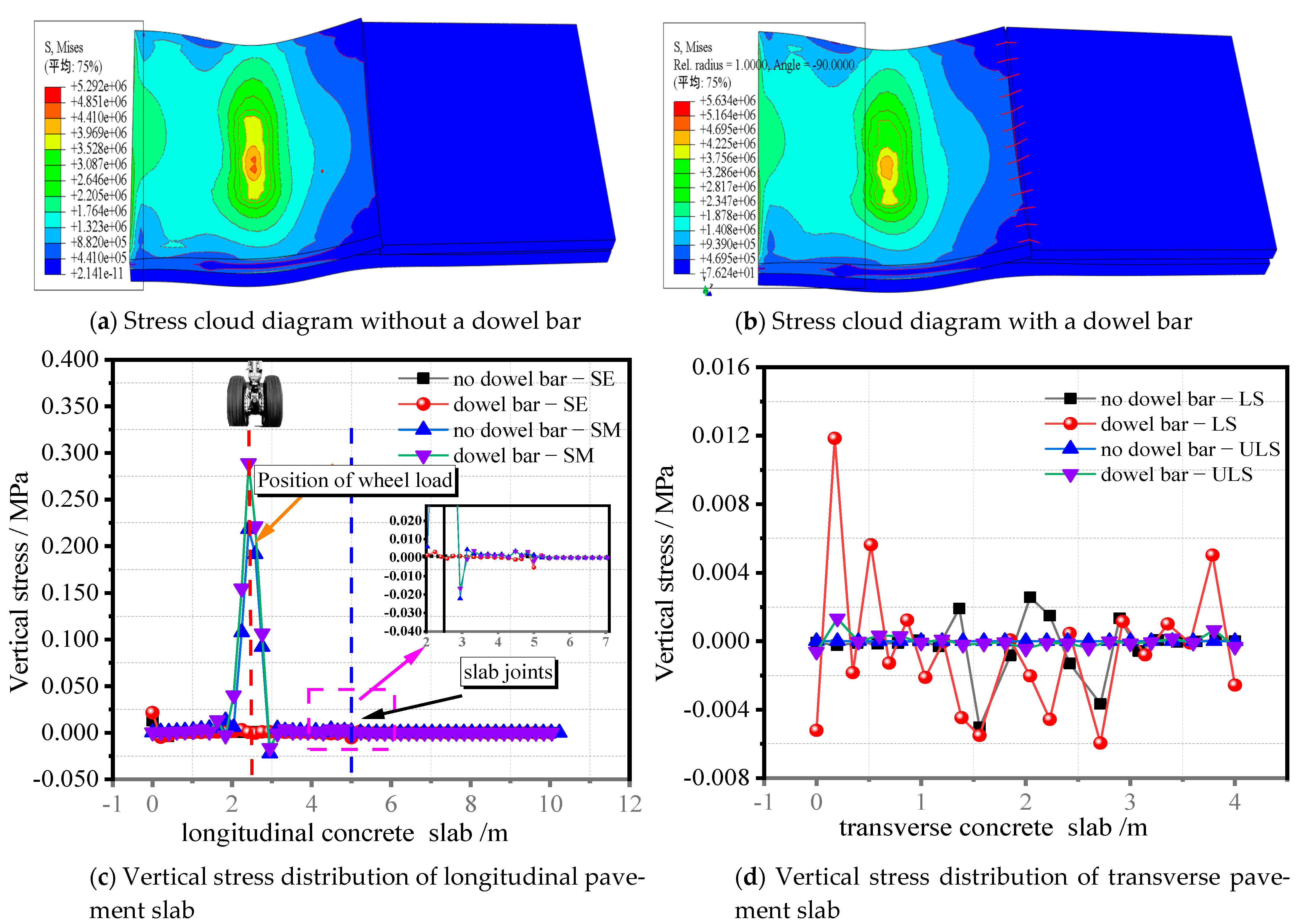

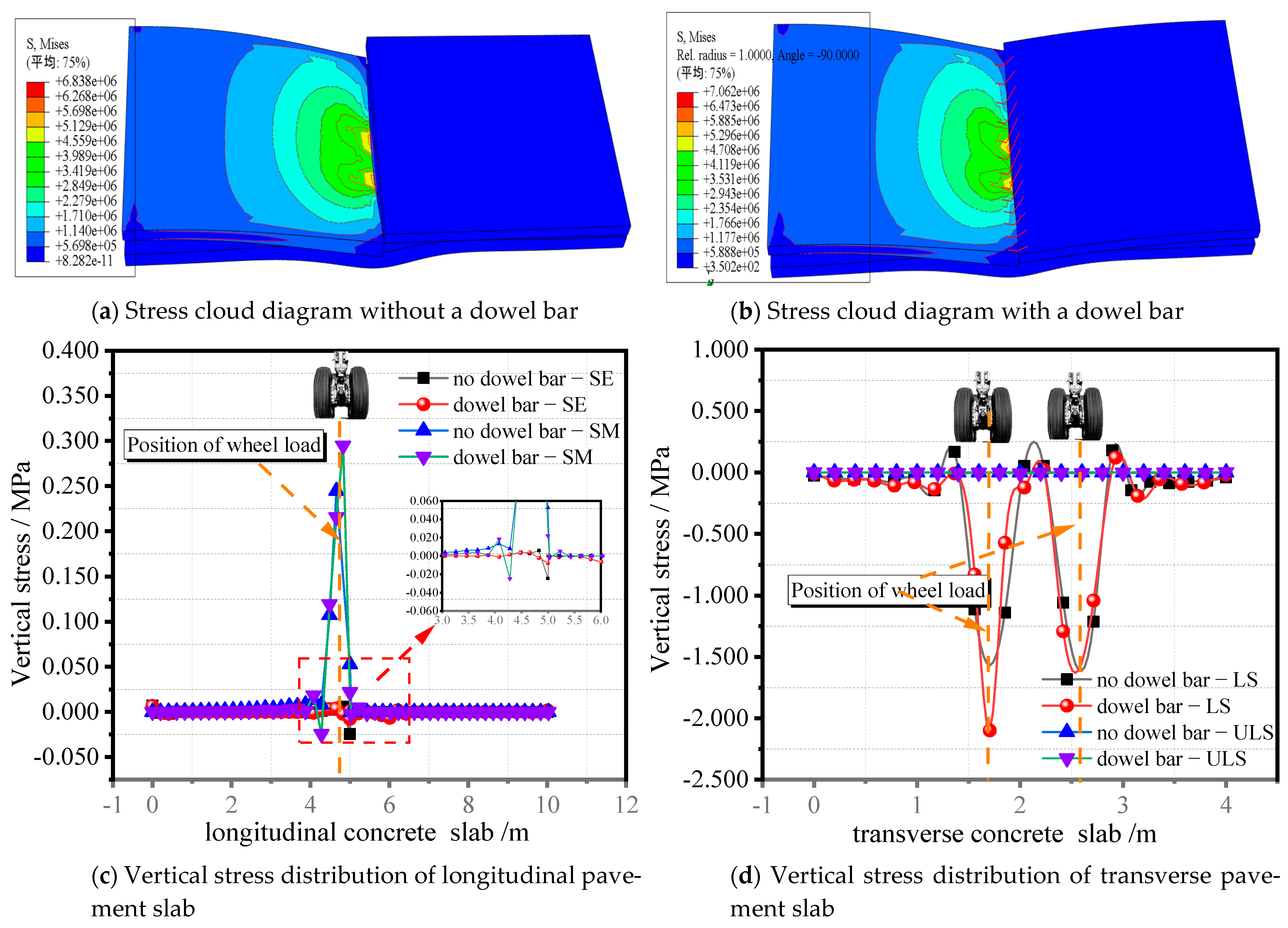
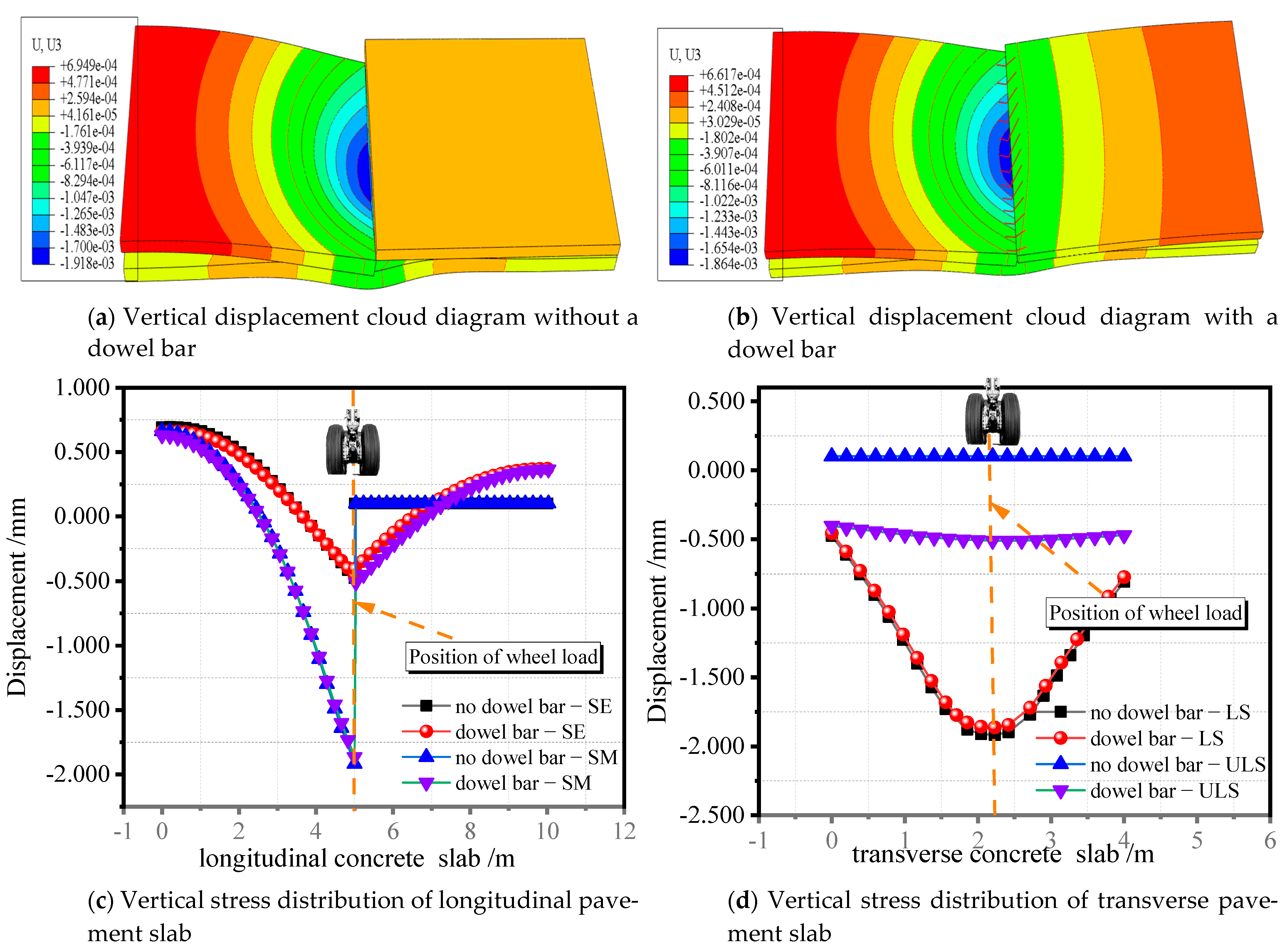
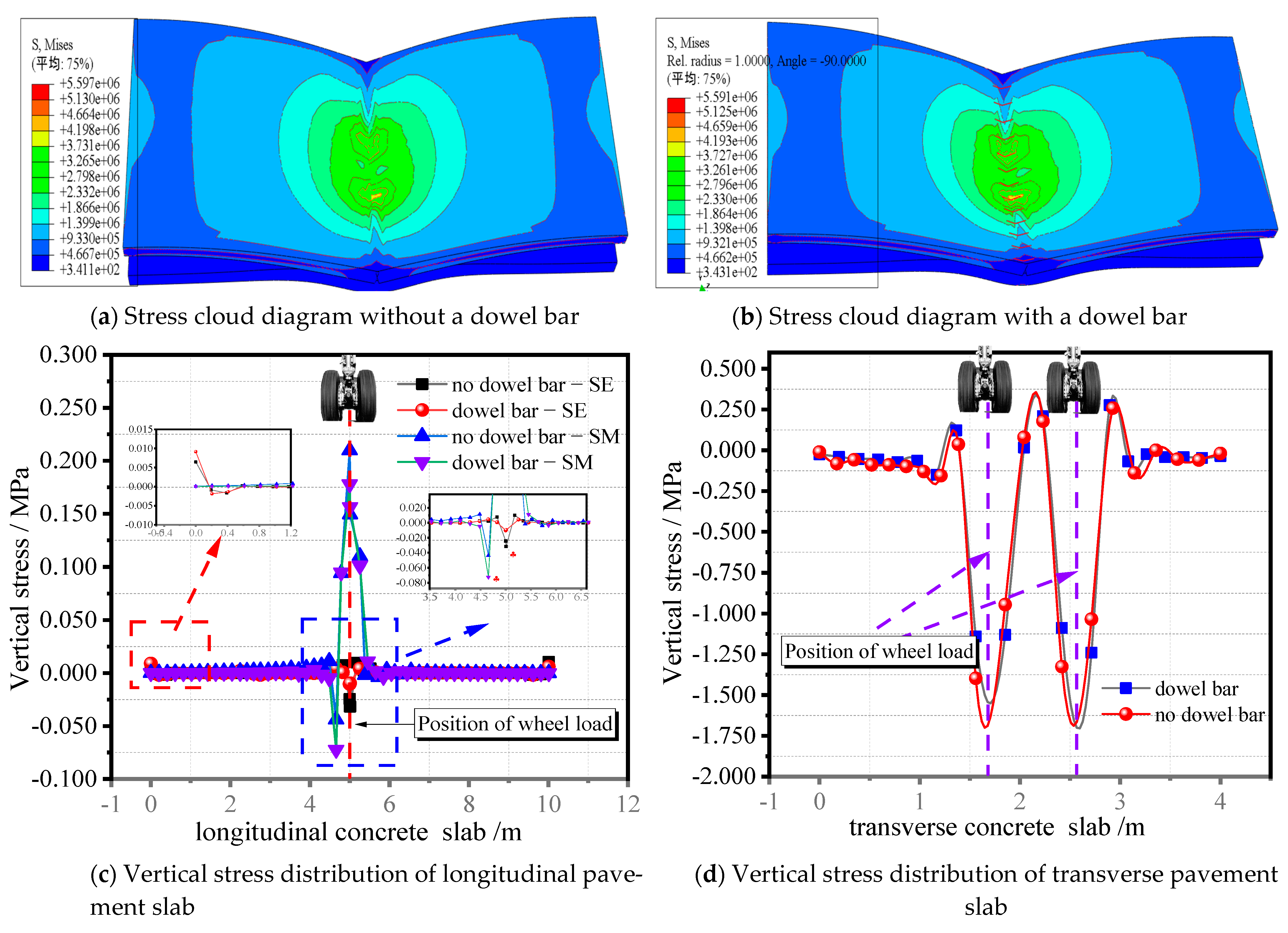
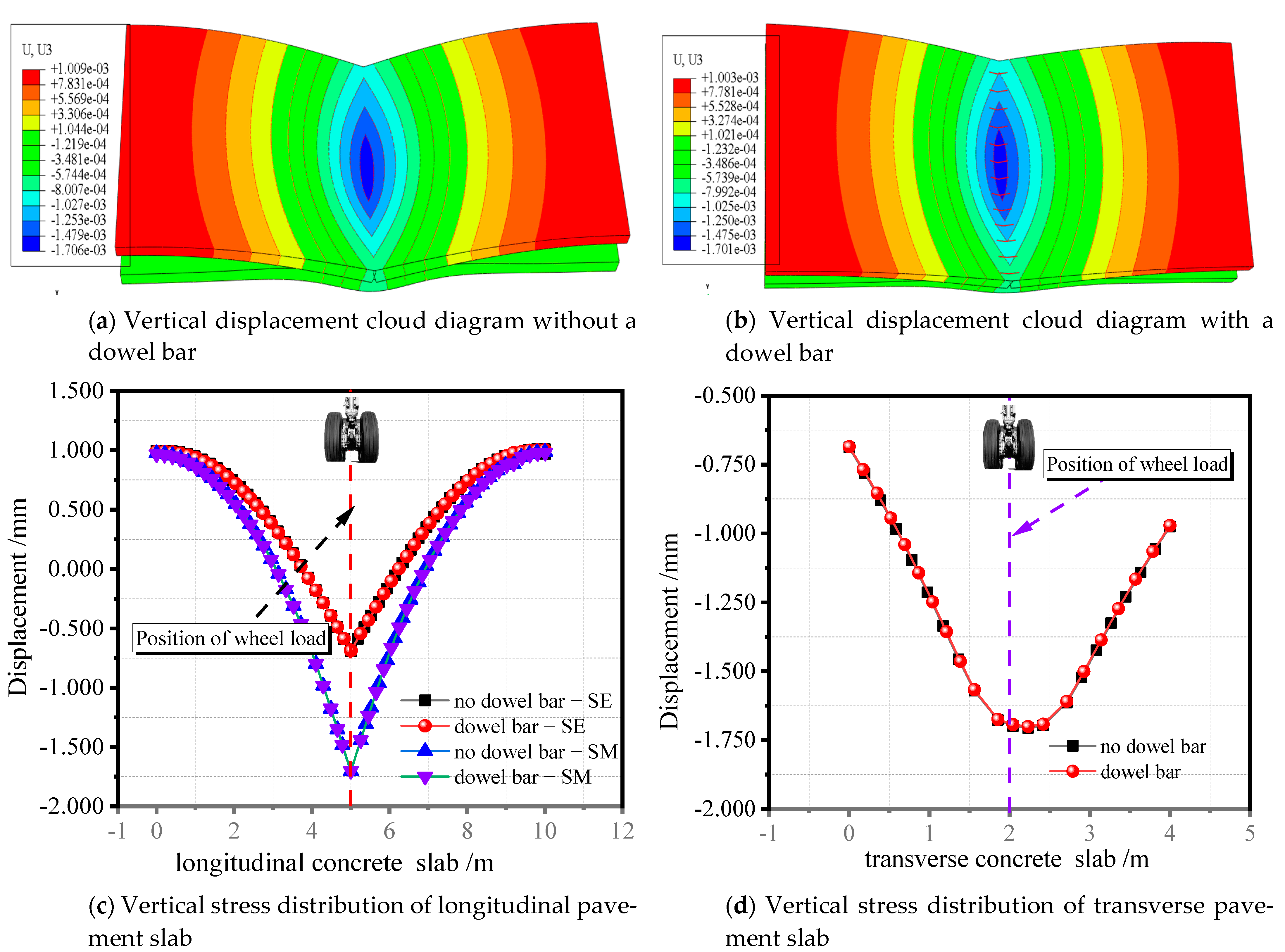
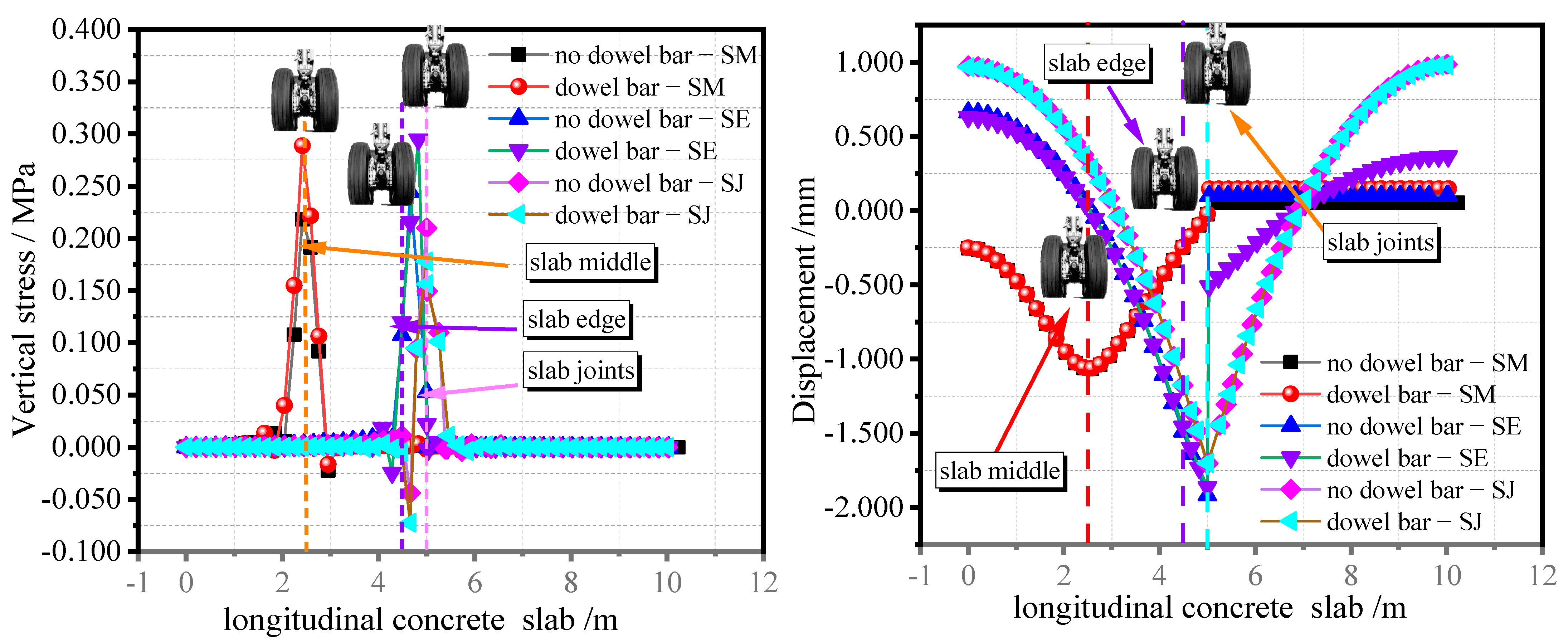
| Aircraft Parameters | Value |
|---|---|
| Suspension system mass (m2)/kN | 328 |
| Non-suspension system mass (m1)/kN | 74.55 |
| Rear landing gear tire stiffness coefficient (k1)/kN·m−1 | 9600 |
| Rear suspension stiffness factor (k2)/kN·m−1 | 4800 |
| Rear landing gear tire damping factor (c1)/kN·m−1·s−1 | 24 |
| Rear suspension buffer damping factor (c2)/kN·m−1·s−1 | 20 |
| Maximum ramp weight | 792.60 kN | Main landing gear spacing | 5.72 m |
| Maximum takeoff weight | 790.04 kN | Number of main landing gear | 2 |
| Maximum landing weight | 663.80 kN | Landing-gear tread | 0.86 |
| Maximum fuel-free weight | 627.50 kN | Main landing gear configuration | Double round |
| Empty weight | 414.30 kN | Main landing gear tire pressure | 1.47 MPa |
| Main landing gear load distribution factor | 0.950 | ||
| Parameters | Cement Concrete Pavement | Cement-Stabilized Macadam | Base |
|---|---|---|---|
| Thickness/m | 0.24 | 0.3 | -- |
| Elasticity modulus/MPa | 38,000 | 1500 | 2000 |
| Poisson’s ratio | 0.15 | 0.25 | 0.3 |
| Position of Wheel Load | Vertical Stress/MPa | Flexural-Tensile Stress/MPa | ||||||
|---|---|---|---|---|---|---|---|---|
| No Dowel Bar | Dowel Bar | No Dowel Bar | Dowel Bar | |||||
| Slab Edge | Slab Middle | Slab Edge | Slab Middle | Slab Edge | Slab Middle | Slab Edge | Slab Middle | |
| SM | 0.013 | 0.022 | 0.218 | 0.289 | 0.003 | 0.005 | 0.022 | 0.016 |
| SE | 0.007 | 0.007 | 0.245 | 0.295 | 0.024 | 0.008 | 0.001 | 0.025 |
| SJ | 0.010 | 0.009 | 0.210 | 0.178 | 0.032 | 0.010 | 0.044 | 0.072 |
Publisher’s Note: MDPI stays neutral with regard to jurisdictional claims in published maps and institutional affiliations. |
© 2022 by the authors. Licensee MDPI, Basel, Switzerland. This article is an open access article distributed under the terms and conditions of the Creative Commons Attribution (CC BY) license (https://creativecommons.org/licenses/by/4.0/).
Share and Cite
Liu, C.; Chong, X.; Wang, L.; Zhang, J.; Chen, Z.; Lin, F.; Bai, P. Numerical Analysis on the Mechanical Properties of the Concrete Precast Pavement of Runways under the Wheel Load. Appl. Sci. 2022, 12, 9826. https://doi.org/10.3390/app12199826
Liu C, Chong X, Wang L, Zhang J, Chen Z, Lin F, Bai P. Numerical Analysis on the Mechanical Properties of the Concrete Precast Pavement of Runways under the Wheel Load. Applied Sciences. 2022; 12(19):9826. https://doi.org/10.3390/app12199826
Chicago/Turabian StyleLiu, Chaojia, Xiaolei Chong, Lefan Wang, Jichao Zhang, Zhenglei Chen, Fantong Lin, and Pengkun Bai. 2022. "Numerical Analysis on the Mechanical Properties of the Concrete Precast Pavement of Runways under the Wheel Load" Applied Sciences 12, no. 19: 9826. https://doi.org/10.3390/app12199826







